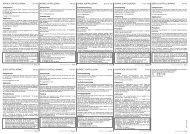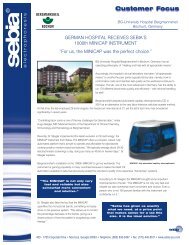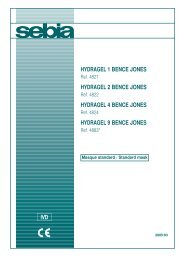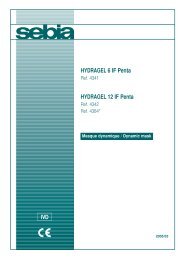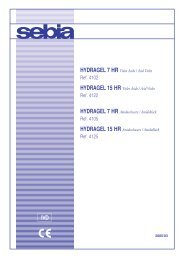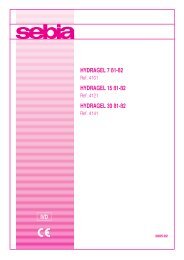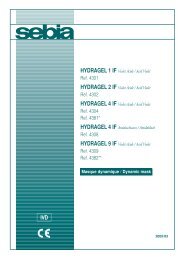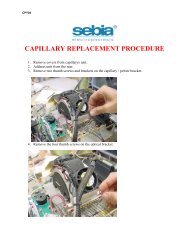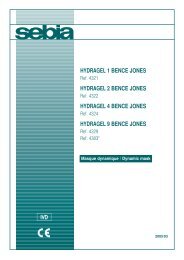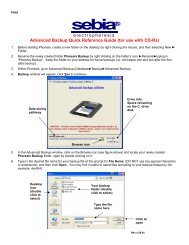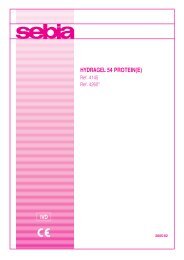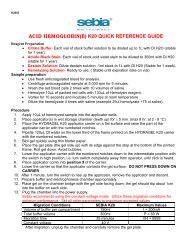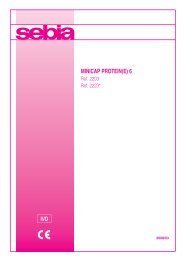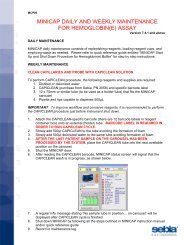CAPILLARYS HEMOGLOBIN(E)
CAPILLARYS HEMOGLOBIN(E) - Sebia Electrophoresis
CAPILLARYS HEMOGLOBIN(E) - Sebia Electrophoresis
- No tags were found...
You also want an ePaper? Increase the reach of your titles
YUMPU automatically turns print PDFs into web optimized ePapers that Google loves.
<strong>CAPILLARYS</strong> <strong>HEMOGLOBIN</strong>(E) - 2010/10<br />
1. BUFFER<br />
Preparation<br />
The buffer is ready to use. It contains: alkaline buffer pH 9.4 ; additives, nonhazardous at concentrations used, necessary for optimum performance.<br />
WARNING: See the safety data sheet.<br />
Use<br />
Buffer for analysis of hemoglobins in <strong>CAPILLARYS</strong>.<br />
Storage, stability and signs of deterioration<br />
Store the buffer refrigerated (2 to 8 °C). It is stable until the expiration date indicated on the kit package or buffer vial labels. Avoid storage at room<br />
temperature for a long time or close to a window or to a heat source.<br />
DO NOT FREEZE.<br />
IMPORTANT: When stored at 2 - 8 °C and prior to use, it is necessary for the buffer to reach room temperature; when it is full, let the buffer vial at<br />
room temperature for at least 3 hours prior to use. If this precaution is not respected, the performances of the procedure may be affected.<br />
WARNING: Do not pre-heat the buffer in hot water.<br />
Once the buffer vial has been opened and positioned on the <strong>CAPILLARYS</strong> system, it is stable for a maximum of 1 month (accumulated) at room<br />
temperature (15 to 30 °C). After each use, the buffer must imperatively be stored refrigerated (between 2 and 8 °C) without any delay, it is then<br />
stable until the expiration date indicated on the buffer vial label.<br />
IMPORTANT: The accumulated time of the buffer stored at room temperature must not exceed 1 month. This time of 1 month storage takes account<br />
of the time for the buffer to come to room temperature.<br />
Discard buffer if it changes its appearance, e.g., becomes cloudy due to microbial contamination.<br />
2. HEMOLYSING SOLUTION<br />
Preparation<br />
Hemolysing Solution is ready to use. It is a buffer with additives, nonhazardous at the concentration used, necessary for optimum performance.<br />
Use<br />
To dilute and hemolyze red blood cells and whole blood.<br />
Storage, stability and signs of deterioration<br />
Store Hemolysing Solution refrigerated (2 to 8 °C). It is stable until the expiration date indicated on the kit package or Hemolysing Solution vial label.<br />
Avoid storage at room temperature or close to a window or to a heat source. DO NOT FREEZE.<br />
WARNING: Do not pre-heat the hemolysing solution in hot water.<br />
IMPORTANT: After each use, close immediately and tightly the hemolysing solution vial and store it refrigerated.<br />
Analyses with the <strong>CAPILLARYS</strong> 2 FLEX PIERCING system: Once the hemolysing solution vial has been opened and positioned on the system, it is<br />
stable for a maximum of 2 months (accumulated) at room temperature (15 to 30 °C).<br />
Discard Hemolysing Solution if it changes its appearance, e.g., becomes cloudy due to microbial contamination.<br />
3. WASH SOLUTION<br />
Preparation<br />
The vial of the stock wash solution should be diluted up to 750 mL with distilled or deionized water.<br />
WARNING: See the safety data sheet.<br />
Use<br />
For washing the capillaries before and after hemoglobin electrophoresis.<br />
IMPORTANT: Before filling the wash solution container, it is recommended to wash the opening of the container, the connector and the tube with plenty<br />
of distilled or deionized water to avoid salts deposit.<br />
Storage, stability and signs of deterioration<br />
Store the stock and working wash solutions in closed containers at room temperature or refrigerated. The stock wash solution is stable until the<br />
expiration date indicated on the kit or wash solution vial label.<br />
Working wash solution is stable for 3 months.<br />
Discard working wash solution if it changes its appearance, e.g., becomes cloudy due to microbial contamination.<br />
4. DILUTION SEGMENTS<br />
Use<br />
Coloured single use segments for blood sample dilution on the automated instrument. They are specific for <strong>CAPILLARYS</strong> <strong>HEMOGLOBIN</strong>(E) and<br />
<strong>CAPILLARYS</strong> CORD BLOOD procedures.<br />
WARNING: Dilution segments with biological samples have to be handled with care.<br />
5. FILTERS<br />
Use<br />
Disposable filters for filtration of analysis buffer, hemolysing solution (for <strong>CAPILLARYS</strong> 2 FLEX PIERCING system), working wash solution and<br />
distilled or deionized water (used for capillaries rinsing).<br />
IMPORTANT: With each new kit, always change all the four filters.<br />
Screw one filter at the connector situated at the extremity of each tube that plunges in the vials of buffer, hemolysing solution, wash solution and<br />
distilled or deionized water. When setting filters on <strong>CAPILLARYS</strong> system, rinse the connectors and the tubes with distilled or deionized water. Used<br />
filters must be rinsed before discard.<br />
The filter intended for analysis buffer must be used for filtration of both buffer vials ; the three other filters are intended for filtration of hemolysing<br />
solution, working wash solution and distilled or deionized water (for capillary rinsing).<br />
Storage<br />
Before use, store the filters in their sealed package in a dry place at room temperature or refrigerated.<br />
- 35 -



